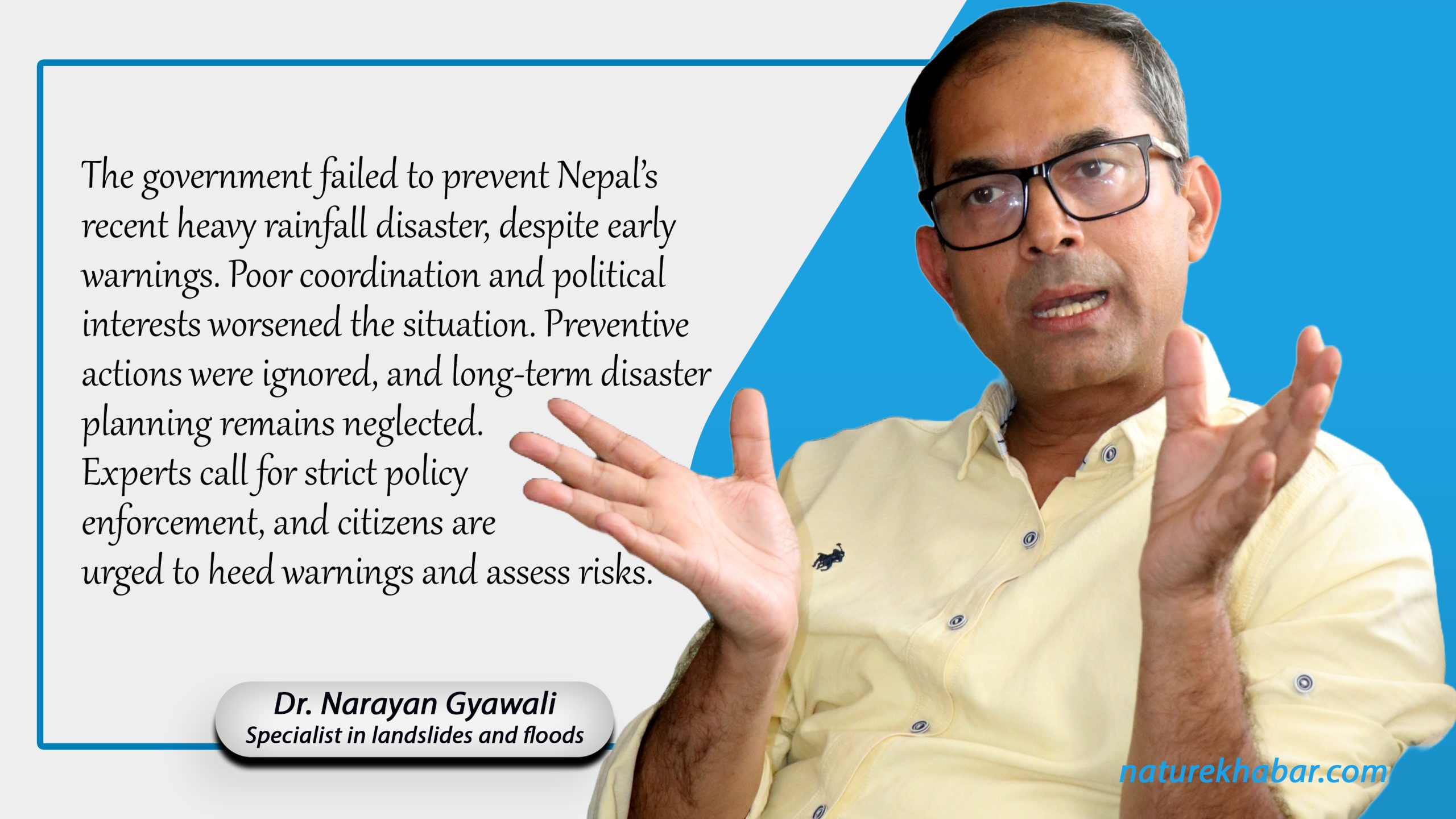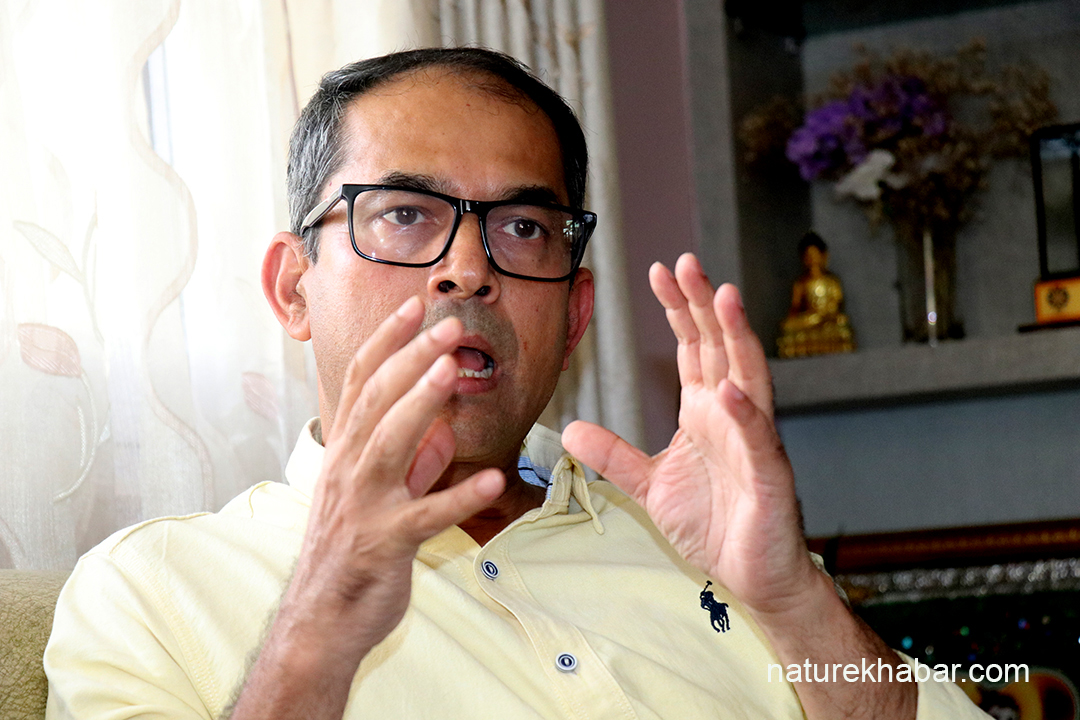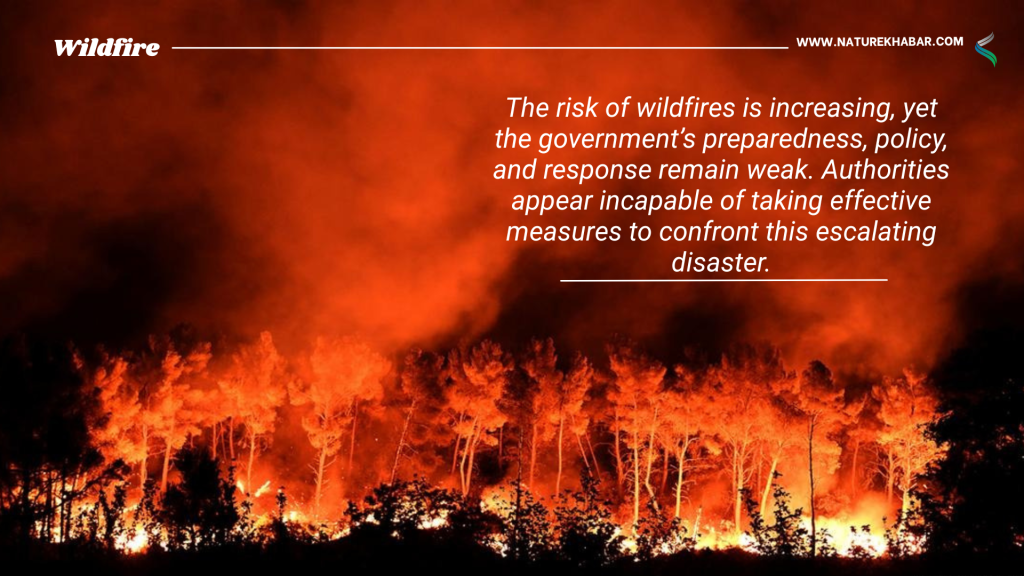Despite prior warnings, the government failed to minimize the damage: Dr. Gyawali

On september 27 and 28, there was a severe loss of life and property due to heavy rainfall, especially in eastern and central Nepal. Data from the government indicates that the province of Bagmati suffered the most. The central government was unprepared when even Kathmandu, the federal capital, was flooded. In addition to its shortcomings in long-term planning, the government's rescue and relief operations were ineffective. The Hydrology and Meteorology Department had projected the possibility of severe rain over two weeks in advance, and the Disaster Authority had already foreseen such a scenario back in May. Nevertheless, in spite of the warnings, nothing was done. As a result, although residents suffer the most, the government is now the target of accusations.
Experts claim that the government might have prevented a significant portion of the damage if it had taken action based on previous judgments and projections. The administration is still having trouble with damage control and relief efforts since it was unprepared for an early intervention.
In two days, sudden, intense rains wreaked billions of dollars' worth of damage. These kinds of catastrophes are unavoidable because of the growing effects of climate change. Communities near rivers and in susceptible geographic areas are still at danger. Experts like Dr. Narayan Gyawali caution that Nepal will continue confront difficulties of this kind if the government does not put long-term measures into place to consistently reduce disasters. It's sad that governments at all three levels are still immature, even though our early warning systems have improved.
Dr. Gyawali spoke with NatureKhabar's Executive Editor Rabin Bhattarai about the flood and landslide scenario. Dr. Gyawali recently finished his PhD in flood and landslide studies at the Agriculture and Forestry University, Rampur, Chitwan.
Were the landslides and rainfall in Nepal last week predicted or out of the ordinary?
• Although they appear unexpected at first, they were actually rather common given Nepal's weather trends. Our traditional rainy season runs from June to September, so the recent rains seem a little out of the ordinary because they follow a pattern similar to the post-monsoon. Given the recent changes in rainfall patterns, the amount and timing of the rain seemed unusual. The highest rainfall typically occurs in June, July, and August, but it is currently peaking in September, suggesting a clear change in the pattern of precipitation.
However, didn't these rains produce greater harm than normal? Why?
• It's true that the damage exceeded expectations. The fact that this occurred in spite of prior knowledge is astounding. The weather has been predicted for a long time. The Department of Hydrology and Meteorology gave warnings ahead of time, even identifying sensitive locations, and the Disaster Authority had meetings in May anticipating a situation similar to the current one. But there was no attempt to lessen the harm, and now we have to deal with the fallout. Not only are local government agencies and residents of high-risk areas to blame, but also the government itself is failing.
The disaster itself continued to impede the government's attempts for disaster prevention. Plans are created for disaster mitigation, however they are not carried out.
Does this mean that despite the fact that our agencies and technology are able to provide precise early warnings, the government chose not to act upon them ?
• In the past, early warnings were frequently unreliable, which resulted in carelessness. But recently, the Hydrology and Meteorology Department and the Disaster Authority have both improved, releasing warning messages and offering regular three-day predictions. The administration disregarded these alerts in spite of this advancement. Even choices like ending night bus services were made but not implemented, and the May projections were not given any weight. The fact that riverbank settlements were left in place caused this significant devastation. Even people who lived in the areas that were expected to be dangerous disregarded the warnings. Within the government itself, there was a lack of coordination.

In a federal system with three tiers of government and early warnings in place, who was responsible for mitigating the damage?
• The three tiers of government are accountable to each other. The federal, provincial, and municipal governments must coordinate and work together during such emergencies. It was the responsibility of all three governments to make plans to lower the dangers after getting early warnings. But that didn't actually happen. Transportation networks might have been managed, individuals in at-risk locations could have been transferred in time, and travelers could have been alerted if the central government had given directions and organized security personnel. This substantial damage resulted from none of these actions being taken.
It is obvious that the state has been negligent when it is unable to save lives despite hours of requests for assistance.
We continue to assert that the administration lacks coordination skills. However, the most of the damage happened in the capital valley, which is home to a sizable central government presence. People died as citizens. Clearly, the federal government was unprepared. The provinces and local governments' only option was to respond, "We don't have the resources." Is everyone simply attempting to evade accountability? Why does this occur ?
• Yes, back in May, the authority had developed a plan. Possible situations were evaluated. It was decided who would take what action to reduce potential harm, with a special emphasis on floods. Reports were prepared and in-depth conversations were conducted. The authorities did provide their conclusions to different branches of government. It even included numbers regarding the potential number of impacted citizens and the extent of damage in certain regions. This was all completed in May. But by October, the anticipated harm had materialized. It is clear that the government neglected the authority's tasks. Even the prime minister's words now show how lightly the central government regarded it. The crisis was so bad that the federal government itself had to get involved in the rescue effort. It's The administration was obviously insincere, and now they're attempting to shift the blame elsewhere.
We have talked about the latest calamity. Let us now change our attention. Natural catastrophes like landslides and floods are very likely to occur in our nation. Every year, there is damage. Where is the risk of calamity for our nation marked on the world map ?
• From the standpoint of disaster risk, Nepal is ranked 14th in the world. That implies that various calamities affect our nation. Landslides and floods are the most frequent, followed by lightning strikes and earthquakes. Glacier lake outbursts have also been more frequent recently. In addition to the increased rainfall in areas like Manang and Mustang, the effects of climate change are also readily apparent throughout our nation. Nepal is a lovely and little country, yet it is among the worst in the world when it comes to natural disasters. According to research, the average global temperature is only rising by 0.03°C, but Nepal's temperature is rising by 0.056°C yearly. This might not seem like much, but if Nepal's temperature rises at this rate, there will be more natural calamities. Nepal is currently ranked ninth among the top 10 countries in the world most affected by floods and landslides, and glacier lakes could rupture more frequently.
While decisions were taken to stop nighttime bus services, they were not carried out, and buses continued to run. There was no relocation of riverbank settlements.
It appears that the effects of landslides and floods have changed recently. There have been more heavy downpours, floods, and unnaturally fast glacial lake outburst. Does climate change have a role in these Nepalese disasters ?
• Indeed, there is a lot of evidence to support the theory that climate change has made these disasters worse. The patterns of the weather have shifted. Certain crops that once thrived there are no longer there. The springs are no longer flowing. Places with little rainfall in the past now suffer from deluges of rain and flooding. Illnesses and agricultural output from the Terai region are moving uphill. These slow changes are starting to pose a greater threat than unexpected landslides and floods. Changes in rainfall patterns accelerate landslides and floods because the ground is unable to absorb the water. The effects of climate change are to blame for all of this.
Since many of Nepal's communities are situated along rivers, water from rupturing glacial lakes has the potential to sweep any of these buildings away. As a result, it's not enough to simply keep an eye on the weather; you also need to be aware of the threats that climate change poses and take appropriate precautions.

Unplanned road building carried out in the name of development has been seen to exacerbate flooding in the Terai and cause landslides, particularly in mountainous regions. Has disasters themselves been caused by development ?
- Building roads appears to be the definition of development at all levels of government. Building roads in their districts is a top priority for even elected ministers and members of parliament. People want roads to run directly in front of their houses. But there isn't enough knowledge. In the name of progress, roads have been constructed everywhere, with little regard for the effects on the environment or the likelihood of landslides and floods in the future. The hills have been severely damaged by highways that are frequently dug without engineering oversight and are completed by unskilled excavator operators. Anywhere there are roads, landslides happen. Due to improper water drainage systems, uncontrolled excavation and shoddy building have made monsoon floods in the Terai worse. Thus, it is true that uncontrolled development has made tragedies more massive.
People in risky regions might have been relocated to safer ones if the central government had issued directives and dispatched security personnel.
Both the government and the populace bear some of the blame for how development has led to calamities. Which policy choices do you believe the government should adopt in order to lower the likelihood of disasters ?
• It is undeniably necessary to alter policies. There are problems with the laws governing agriculture, building, and land usage. It is not sufficient to create policies merely to collect money. Strict regulations must be put in place by the government to guarantee properly designed urban settlements, functional drainage systems, and environmentally responsible road building. An environmental impact analysis must be completed prior to road construction, and engineers should supervise the process. Deforestation and replanting must also be addressed by policies, guaranteeing that trees that are chopped down are always replaced. There are policies in place, but they are not followed.
Particularly, the government must create new policies as needed and carefully enforce the ones it already has, notably those that define river zones, control riverbed exploitation, and avoid obstructing natural rivers. All levels of government need to take this seriously and respond.
Government organizations have policies in place, so why are they reluctant to put them into effect? What discoveries did your research yield ?
• Politics is the primary concern. Political party leaders have powerful positions, and local lawmakers are members of these same parties. A large portion of their voter base consists of rule-breakers, from irresponsible contractors to individuals camped out on riverbanks. Their voting banks are located in the same places that policies need to be implemented. How therefore can the powerful act? This is the main obstacle. Political interests keep municipal, provincial, and federal governments from implementing rules, despite the Management Authority and the Meteorological Department alerting the government in a timely manner. Rather, they utilize calamities as a pretext for politics after the fact. This is the main issue facing our nation.
In addition to the individuals themselves, the government and local organizations in high-risk areas bear some of the blame.It is insufficient to just hand out snacks and erect tents!
The damage from a few hours of rain totaled billions. There are no roads left. More of these kinds of catastrophes are very likely. Which long-term fixes ought the government to take into account?
• Major roadways were devastated by two days of rain, which also resulted in a large loss of life and property. Even in terms of responding quickly to rescue and relief efforts, the administration has fallen short. Some were carried away while they waited for assistance. The state failed in its duty because it took hours for rescuers to show up. The Home Minister's responses come out as if they don't comprehend the circumstances. The weather forced helicopters to land. There were not enough secure rescue trucks in the Kathmandu Valley. I've even heard that Lalitpur's mayor declared, "We should buy boats because we need them now." This indicates that no preparations had been made by the government.
The hazards are simply going to get bigger. There is danger to settlements beside rivers and beneath glacier lakes. Every district, from east to west, is currently dealing with a disaster of some kind. The government must prioritize moving communities from high-risk locations in addition to providing humanitarian supplies.

How can the government work with foreign groups and donors to find long-term solutions? What level of assistance may Nepal anticipate from them ?
• Numerous foreign groups have already arrived in Nepal and are inquiring about possible projects from the government. Numerous international organizations and nations are eager to assist in preventing and mitigating disasters. However, the government must present them with well-thought-out strategies and advise them on how to avoid calamities. "After a calamity, the government cannot simply request assistance. It can draw in foreign assistance, grants, and loans if it works effectively in coordination and provides catastrophe risk reduction plans with distinct first, second, and third phase tasks. But the job needs to be done by the government. There won't be any issues if they have talks with international development organizations once or twice a year. A further problem is the extremely low level of funding for research. The government must set aside money for study and use the results to formulate precise policies. After that, it will be able to approach international partners and say, "This is what we need help with."
Nepal might obtain a lot of grants, loans, and international aid by defining first, second, and third-stage measures in disaster mitigation plans.
So the government's primary priority has been rescue and relief efforts thus far ?
• The government hasn't taken any sustained action to lower the likelihood of disaster as of yet. Its priorities remain undefined. There is currently no government funding or report dedicated to the study and research of catastrophe prevention. Plans and funding from the government are solely concerned with funding supplies for relief and rescue operations. However, distributing instant noodles, beaten rice, and tents is insufficient. Where are the strategies to avoid these circumstances in the first place? To put it bluntly, the government has not made disaster risk mitigation a priority. All three levels of government seem to be waiting for disasters to strike because their preparations are primarily concerned with rescue and relief efforts. Furthermore, the government has shown weakness even in these areas. Effective coordination between the government and its own systems as well as development partners has proven to be elusive.
How can citizens help lower the danger of disaster ?
• We've talked about the faults of the government. The government bears primary responsibility for formulating policies that impact residents and for enforcing laws and regulations. But citizens cannot depend solely on their government. They also need to evaluate the dangers associated with their current residence. They must understand the property and the dangers associated with where their residences are located. Knowledgeable decisions can minimize material and human losses. Additionally, people should heed the alerts that the authorities have issued.

 Rabin Bhattarai
Rabin Bhattarai




Feedback